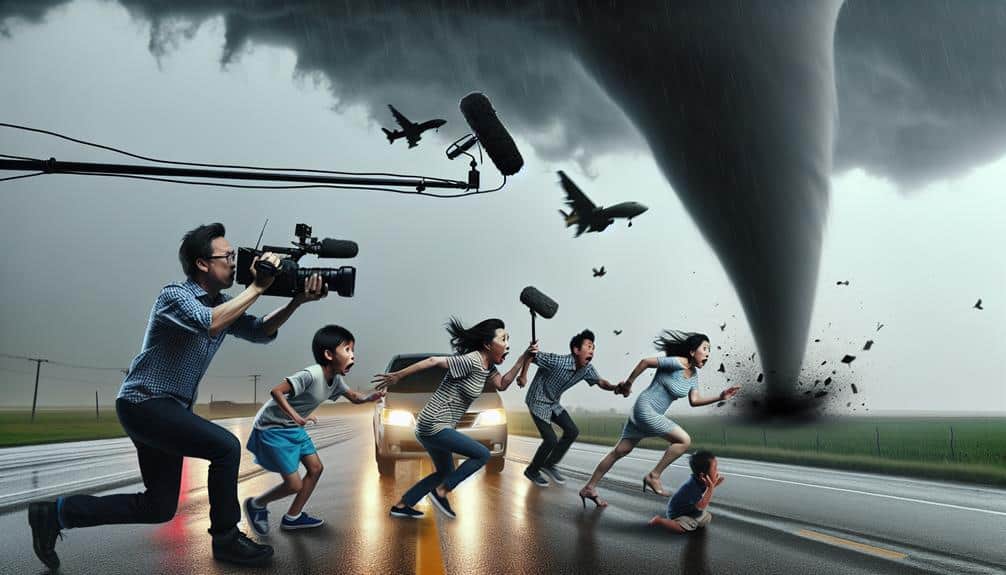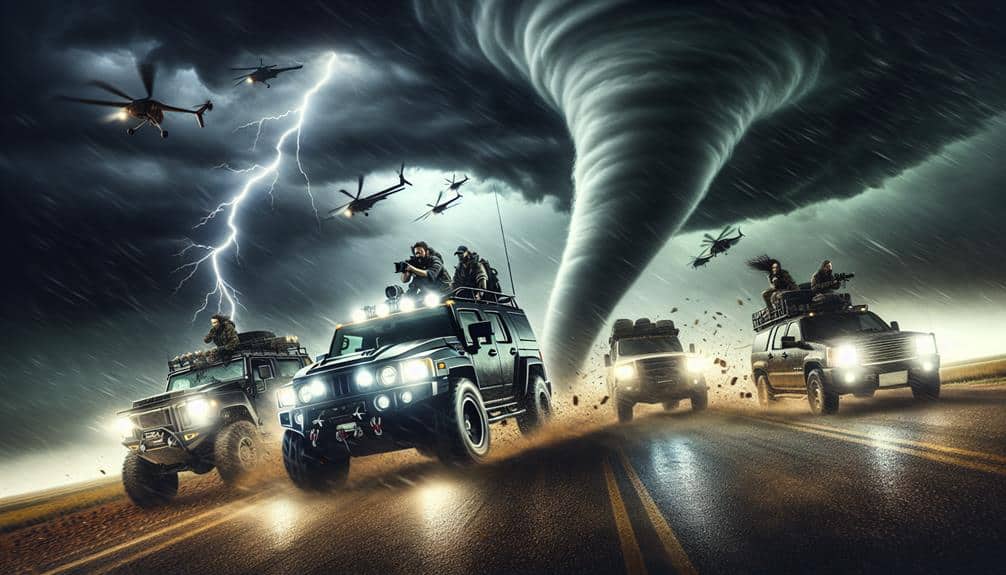We've seen storm chaser coverage evolve from a scientific endeavor into a sensationalized spectacle. Media coverage often prioritizes fear and entertainment over accuracy, utilizing biased storytelling to captivate audiences. This shift has greatly impacted public perception, amplifying fear and misunderstanding of natural phenomena. Ethical concerns arise as sensationalism undermines journalistic integrity and public trust. Responsible reporting must prioritize factual accuracy and transparency to counteract misinformation. To explore how these practices shape our understanding and evaluate steps for cultivating trust, we need to examine the underlying dynamics and ethical considerations of storm chaser media coverage.
Key Points
- Shift from scientific documentation to entertainment-focused content in storm chaser coverage.
- Prioritization of sensationalism and fear mongering over delivering scientifically accurate information.
- Use of bias and storytelling techniques to enhance the dramatic appeal of severe weather coverage.
- Ethical concerns raised due to compromised journalistic integrity and misinformation spread.
Origins of Storm Chaser Coverage
The origins of storm chaser coverage can be traced back to the early 1950s when meteorologists and thrill-seekers began documenting severe weather phenomena to better understand and predict these natural events. This period marked an impactful history in the field of meteorology and media. Initially, our focus was purely scientific, aimed at advancing our knowledge of thunderstorms, tornadoes, and hurricanes. Early footage and data collection paved the way for improved forecasting techniques, potentially saving countless lives.
As media evolved, so did the nature of storm chaser coverage. The advent of portable cameras and later, digital technology, enabled us to capture more detailed and dramatic imagery of severe weather. This evolution wasn't just about better equipment; it also signaled a shift in how these events were shared with the public. What started as niche scientific documentation gradually transformed into mainstream media content.
We began to see television networks and documentary filmmakers embracing the raw, unfiltered power of nature. They recognized the compelling nature of these events, which often translated into higher viewership. Therefore, storm chaser coverage evolved from a scientific endeavor into a media spectacle, reflecting broader changes in how society consumes information and entertainment.
Typical Media Narratives
As storm chaser coverage shifted from scientific documentation to mainstream media content, we observed the emergence of typical media narratives that often prioritize sensationalism over scientific accuracy. Media bias and storytelling techniques now drive much of the coverage we see, focusing heavily on fear mongering and entertainment value. This shift has altered how storms are presented to the public, emphasizing drama and danger at the expense of nuanced, factual reporting.
We notice that media outlets often employ storytelling techniques that exaggerate the destructive potential of storms, creating a narrative that keeps viewers on the edge of their seats. By framing storm chasers as daredevils braving nature's fury, the media adds an element of human drama that captivates audiences. This approach, while compelling, can distort public perception and understanding of severe weather events.
The focus on entertainment value also leads to a tendency to highlight the most extreme footage and scenarios. While this grabs attention, it reinforces fear mongering, overshadowing the educational aspect of storm chasing. Consequently, we lose out on the opportunity to foster a well-informed public, critical for making autonomous decisions during severe weather events.
Sensationalism in Headlines
In storm chaser coverage, we frequently encounter headlines that sensationalize events, prioritizing shock value over informative content. These headlines often rely on clickbait tactics to draw in readers, sacrificing accuracy for attention. The use of fear mongering is prevalent, with language designed to evoke strong emotional responses rather than convey the true nature of the storm or its impact.
We can identify several common patterns in sensationalized headlines:
- Exaggeration: Words like 'monster,' 'apocalyptic,' and 'unprecedented' are used to describe storms, even when the actual threat is less dramatic.
- Omission of Details: Headlines often leave out critical information, such as the specific location or the storm's strength, to create a sense of urgency and danger.
Impact on Public Perception
Sensationalized headlines in storm chaser coverage greatly shape public perception, often leading to misconceptions about the actual risks and realities of severe weather events.
When media outlets prioritize dramatic footage and hyperbolic language, they amplify public fear and distort our understanding of these natural phenomena. This can result in heightened anxiety and a skewed sense of vulnerability among communities, which directly impacts our psychological well-being.
Moreover, the spread of misinformation through sensationalized coverage erodes media trust. When we encounter exaggerated reports repeatedly, it becomes challenging to discern credible sources from those that sensationalize for higher ratings. This mistrust can lead to critical gaps in knowledge, where essential safety information might be disregarded or misunderstood.
Additionally, the psychological effects of constant exposure to alarming news can't be underestimated. We may start to feel helpless and overwhelmed, believing that severe weather is more frequent or more deadly than it actually is. This can influence our decision-making, making us either overreactive or dismissive in the face of actual threats.
Ethical Concerns

We must critically examine the ethical concerns that arise when media outlets prioritize sensationalism over accuracy in storm chaser coverage. This approach often undermines journalistic integrity, creating ethical dilemmas that compromise both the quality of information and public trust.
When sensationalism takes precedence, the line between fact and fiction becomes blurred, leading audiences astray and potentially causing unnecessary panic.
Firstly, sensationalism often leads to misrepresentation of events, which violates the core principles of journalistic integrity. Accurate and honest reporting should always be the foundation of news coverage.
- Misleading Information: Sensationalist coverage can distort the truth, presenting exaggerated scenarios that aren't backed by evidence.
- Public Trust Erosion: When the audience realizes they've been misled, their trust in media outlets diminishes, affecting the credibility of future reporting.
Real Vs. Exaggerated Risks
Many storm chaser reports blur the lines between real dangers and exaggerated threats, often amplifying the perceived risk to capture audience attention. While these reports can be thrilling, they often distort the actual level of danger, leading to misinformed public awareness. We need to critically evaluate the risk assessment presented in these reports. Are the threats depicted truly imminent, or are they sensationalized to boost viewer ratings?
When storm chasers neglect safety precautions for the sake of dramatic footage, they not only endanger themselves but also compromise media responsibility. This lack of responsibility can contribute to a culture of fear, where the public's perception of risk is skewed. Accurate risk assessment is pivotal for ensuring that people understand the real dangers without being unnecessarily alarmed.
Media outlets have a responsibility to present information that balances excitement with accuracy. By doing so, they can help the public make informed decisions about their own safety. We should advocate for responsible reporting that prioritizes truth over sensationalism. Only then can we foster a well-informed public that values both freedom and safety.
Let's demand more from our media: accurate, responsible, and truthful storm coverage.
Future of Responsible Reporting

In the future, responsible reporting in storm chaser coverage will hinge on a commitment to accuracy, transparency, and ethical journalism. We must prioritize these principles to guarantee the information we provide remains reliable and trustworthy.
First, ethics should be at the core of our reporting. We need to avoid sensationalizing events for the sake of viewership and instead focus on presenting the facts as they are. Sensationalism undermines our credibility and can lead to public mistrust.
Second, accountability is vital. We must be willing to own up to mistakes and correct them promptly. This not only enhances our credibility but also reinforces our commitment to ethical journalism.
Third, transparency in our reporting processes will allow audiences to understand how we gather and verify information. This openness fosters trust and empowers the public to make informed decisions based on accurate data.
To help our audience appreciate our commitment, we can:
- Highlight our fact-checking procedures to demonstrate our dedication to accuracy.
- Provide behind-the-scenes looks at our reporting processes for greater transparency.
Frequently Asked Questions
How Do Storm Chasers Prepare for Extreme Weather Conditions?
Did you know 80% of storm chasers strictly follow safety protocols? We make sure our equipment checklist includes GPS, first-aid kits, and communication devices. Preparing thoroughly lets us safely experience the freedom of chasing extreme weather.
What Qualifications Are Required to Become a Storm Chaser?
To become a storm chaser, we need meteorology knowledge, chaser safety training, and the right equipment. Certification isn't mandatory, but understanding weather patterns and having reliable tools are essential for both effective tracking and ensuring our safety.
How Has Technology Advanced Storm Chasing Techniques?
"Necessity is the mother of invention. We've seen technology like drone surveillance and real-time tracking revolutionize storm chasing. These advancements grant us unprecedented freedom to predict, observe, and document storms more accurately and safely than ever before."
What Are the Psychological Effects on Storm Chasers Witnessing Natural Disasters?
We often face emotional trauma when witnessing natural disasters. Our mental health can be strained, but by employing coping strategies, we build resilience. It's essential to address these challenges to maintain our well-being and effectiveness.
How Do Storm Chasers Collaborate With Meteorologists and Emergency Services?
We might think storm chasers act alone, but they collaborate closely with meteorologists and emergency services. These collaborative efforts guarantee accurate data collection and enhance safety protocols, safeguarding communities while allowing us the freedom to explore nature's extremes.


